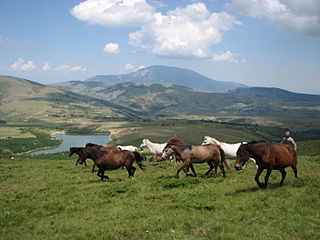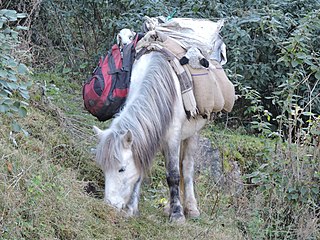
Fars Province, also known as ParsProvince as well as Persis, is one of the 31 provinces of Iran. The province has an area of 122,400 km2 and is located in Iran's southwest, in Region 2. Its administrative center and capital city is Shiraz. Fars neighbours Bushehr province to the west, Hormozgan province to the south, Kerman and Yazd provinces to the east, Isfahan province to the north, and Kohgiluyeh and Boyer-Ahmad province to the northwest.

Qashqai people are a Turk tribal confederation in Iran Almost all of them speak a Western Turkic (Oghuz) language known as the Qashqai language — which they call "Turkī" — as well as Persian in formal use. The Qashqai mainly live in the provinces of Fars, Khuzestan, Kohgiluyeh and Boyer-Ahmad, Chaharmahal and Bakhtiari, Bushehr and southern Isfahan, especially around the cities of Shiraz and Firuzabad in Fars.

The Tersk or Tersky is a Russian breed of light riding horse of Arab type. It was bred at the Tersk Stud in Stavropol Krai in the North Caucasus between about 1925 and 1940.

The Czech Warmblood, Czech: Český Teplokrevník, is a modern Czech breed of warmblood sport horse.

The Pindos is breed of pony or small horse native to the Pindus mountain range in Thessaly and Epirus in Greece. It is also present in mountainous parts of Thrace and Macedonia. There is a feral herd near Neochori, Karditsa, close to Lake Plastiras.

The Falabella is an Argentine breed of small horse. It is among the smallest of horse breeds, with a height at the withers in the range 63–86 cm (25–34 in)..

The Freiberger or Franches-Montagnes is a Swiss breed of horse of light draught type. It originates in the Canton of Jura in north-western Switzerland, and is named for the Freiberge or Franches-Montagnes District in the south of that canton. It is widely distributed in Switzerland, and is also present in France and Belgium.

The Albanian is the only indigenous horse breed in Albania. It is a small horse, and similar to other Balkan horses. Two types are distinguished, a mountain type and a lowland type, which may be called "Myzeqeja" after the lowland Myzeqeja region.

The Deliboz is an Azerbaijani breed of light riding horse. It is an ancient breed which underwent selective breeding in the Azerbaijan Soviet Socialist Republic in the twentieth century. It is one of four extant horse breeds in Azerbaijan, the others being the Karabakh, the Guba and the Shirvan. It may also be called Daliboz or Dilbaz.

The Gelderlander is a Dutch breed of warmblood horse. It was bred in the province of Gelderland in the Netherlands as a carriage horse capable also of farm work. It declined in popularity in the mid-twentieth century. In 1965 it was one of the foundation breeds of the Dutch Warmblood or KWPN, the other being the heavier Groninger horse from the north. It is registered in a division of the Royal Dutch Warmblood Horse Studbook, which also has divisions for the Dutch Warmblood and for the Dutch Harness Horse.

The Sardinian Anglo-Arab or Anglo-Arabo Sardo is an Italian breed of riding horse from the Mediterranean island of Sardinia. It derives from cross-breeding of local mares with stallions of Arab, Anglo-Arab and Thoroughbred stock. Breeding began in 1874; the breed was officially recognised in 1967.

The Dutch Draft, Dutch: 'Nederlands Trekpaard', is a Dutch breed of heavy draft horse. It is of cold-blood type, massively built and calm in temperament; it has good stamina. It was bred in the early twentieth century in the province of Zeeland, and may for that reason be known as the Zeeland Horse or Dutch: 'Zeeuws Paard'. It derives from cross-breeding of local Zeeland mares with the Belgian Ardennes and Brabant breeds, to which it is very similar.
The Nooitgedachter is a South African breed of riding horse. It is the result of a selective breeding programme established in 1952 to preserve the Basutho Pony of Lesotho. It was later decided to give it a different name; it was at first called the Nooitgedacht Pony, named for the Proefplaas Nooitgedacht, the research station near Ermelo in Eastern Transvaal where it was bred; it was later called the Nooitgedacht Horse until the present name was chosen. It is a rare breed, with only about 400 purebreds in existence.
The Pentro or Cavallo Pentro is an endangered Italian breed of small rustic horse. It originates in the upper valley of the Volturno in the southern Italian region of Molise, close to its borders with Abruzzo, Campania and Lazio, and takes its name from the ancient Samnite tribe of the Pentri, who lived in that area. The population is concentrated in the comune of Montenero Val Cocchiara in the province of Isernia. It is one of the fifteen indigenous horse "breeds of limited distribution" recognised by the AIA, the Italian breeders' association.

The Dongola or Dongolawi is an African breed of riding horse. It is predominantly of Barb type, though there may have been some Arab influence in the past. It originated in the Dongola province of Sudan, for which it is named. In eastern Africa it is distributed in the northern part of Sudan and in western Eritrea; it is also present in several West African countries including Cameroon, Chad and the Central African Republic. A number of local West African breeds or types derive from it; they may be regarded as sub-types, or may be reported as separate breeds.

The Spiti Horse is a breed of small mountain horse or pony from Himachal Pradesh in northern India. It takes its name from the Spiti River, and is found mainly in the Kullu, Lahaul and Spiti and Kinnaur districts of the state.

The Strelets Arab or Strelets Horse is an extinct Ukrainian breed of light cavalry horse. It was bred in the nineteenth century at the Striletsky State Stud in Luhansk Oblast of Ukraine, from Arab and a variety of other stock. As with other Russian horse populations, its numbers were gravely reduced by the events of the Russian Revolution and the Russian Civil War, and it came close to disappearing. Two stallions and a few mares survived, which was judged to be too small a number to allow the breed to be recovered. Instead, they were taken to the Tersk Stud in the North Caucasus and used as the foundation stock in the development of the new Tersk breed of riding horse. The Strelets also contributed to the development of the Don and Kustanai breeds.

Koheilan is one of the five major bloodlines of the Arabian thoroughbred horse recognized by the Bedouins, the Al Khamsa. Of tall stature and strong constitution, it owes its name to the beauty of its eyes, set against a black skin that seems naturally enhanced with kohl. The existence of the Koheilan lineage is recounted by the Ottoman traveller Evliya Çelebi in the 17th century, then by the Polish count Wacław Seweryn Rzewuski in the 18th century, who provides a detailed description. He held the horses of the Arabian Najd in the highest esteem, and acquired them for his stud farms. The Koheilan line was widely exported to Central and Eastern Europe, as well as to Russia, where it influenced numerous breeds such as the Najd and Tersk. It has produced the majority of Polish Arabian horses that win endurance ridings.

The history of horsesinIran goes back to Greek sources from ancient Persia, which mention horse worship and the practice of hippomancy. Today, Iranians breed several breeds of horse, most of them Arabian, in particular the Koheilan and Saklawi lines.

The Arabo-friesian is a recent breed of horse, selected over several generations since the 1960s to obtain the morphology of the modern Friesian combined with the endurance qualities of the Arabian. The creation of this breed was strongly contested by some Dutch Friesian breeders, who went so far as to set fire to the stables where the first crosses were made.


















